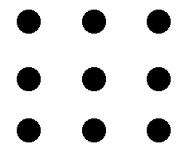Often one of the main barriers to solving a problem is an inability to see the problem in a way that is likely to spark solutions. A source I return to again and again to help me with creative problem solving is James Adams’ Conceptual Blockbusting: A Guide to Better Ideas.
Here are six perceptual blocks Adams identifies along with the information that can help us bust through them:
1. Seeing What You Expect to See – Stereotyping
Recently I encountered a scene familiar to any parent: I came home to find that the chairs in my living room and dining room had been converted – with the aid of a blanket – into a house by my five-year old. These were no mere chairs in his eyes: they were building materials for an entire fantasy world.
Kids provide a constant reminder of how easily we acquire perceptual blocks as we grow older. To a large extent, this isn’t a bad thing: we have to be able to rely on certain preconceptions, assumptions, and even stereotypes about the world around us in order to make sense of things quickly and get through our daily lives.
Problems arise, however, when (a) the foundations for our preconceptions are faulty, and/or (b) we operate on autopilot and don’t periodically test our preconceptions. As I argue frequently on Mission to Learn, cultivating consciousness and a propensity to ask questions is essential for effective learning. They are also essential for problem solving – which, after all, is a learning process.
If you find yourself facing a tough problem, step back a bit and consider whether any preconceptions or stereotypes you hold may be interfering with your ability to find solutions.
2. Difficulty in Isolating the Problem
Sometimes we know there is a problem, but we’re not sure what it is. If you plant a seed in your garden, for example, the expected outcome is that a plant will grow. If it doesn’t, then you have a problem, but the nature of the problem may not be immediately clear. Was the seed bad? Is the soil too acidic? Did you not water enough? Did a bird or squirrel dig up the seed? Often we jump too quickly to an answer to define the problem – e.g., “The seeds I bought are bad” – and end up investing in unnecessary and sometimes costly solutions – e.g., buying new seeds.
We’d be better served by pulling back, looking at the larger objective – which would seem to be successfully growing a plant – and then investigating and experimenting as needed to determine the real problem. Are there tell-tale scratches and holes around where the seed was planted? Have nearby seeds grown successfully, and what was different about how they were tended?
This is a simple example, but a little bit of footwork can go a long way in isolating problems of any size.
3. Defining the Problem Area Too Narrowly
I run into this one all the time in consulting. A prospective client will call up and say something along the lines of “We need you to find a learning management system for us.” A key question to ask in this situation, or in any situation where a solution has been proposed but the desired objective is not clear is … wait for it … Why?
Go back to the gardening problem above. I noted that the objective here seems to be growing a plant. But what if a perceptual block is presenting us from seeing the real objective was to get more fresh vegetables into your diet?
In that case, growing plants is only one of many options. You might also, for example, consider making a trip to the farmers market a part of your weekly routine. Or maybe join a local CSA. If you don’t have the problem defined correctly in the first place, you will completely miss these options.
To help illustrate how we often perceive the problem area too narrowly, Adams’ uses the classic nine dots puzzle. If you haven’t done this before (or even if you have), try connecting the nine dots below using only four lines and without lifting your finger from the screen.
(You can view one popular solution to the nine dots problem here. Adams offers a number of others in his book.)
4. Inability to see the problem from various viewpoints
An ability to see a problem from the viewpoint of everyone the problem impacts not only helps with arriving at consensus around the solution, it can also help greatly in conceptualizing the problem and overcoming some of the barriers already noted. Simply put, when we have to step outside of our own viewpoint, we are bound to see the problem differently, possibly define it differently, and develop different options for solving it than we would when relying solely on our own preconceptions and biases.
Adams notes that “The architect must view the design of his buildings from the perspectives of his clients, his builders, suppliers, architectural critics, and others in his profession as well as his own.” I like the “architect” metaphor both for the reason Adams suggests and because it implies thoughtfully designing solutions to problems rather than defaulting to knee-jerk options.
Next time you are faced with a complex, challenging problem, perhaps think of yourself as a solution architect.
5. Saturation
Many years ago in grad school I spent an inexplicable amount of time studying avant-garde poetry and art. A common refrain across nearly any avant-garde group in any part of the world is “Make it new!” The driving idea behind this refrain is that we tend to lock in on familiar elements of the things around us, and after a while, we begin to ignore them to the point that we can’t really even recall them in any great detail, much less fully appreciate them.
Try, for example, to draw the heads side of a penny (or a coin in the currency of your country). Don’t worry about your artistic skills, just focus on details like whether you are able to face Lincoln’s head in the right direction or put the right text on the drawing. Chances are high you will make mistakes and leave some things out. It’s too familiar for your to “see” it clearly.
Avante garde artist know that the way to shake up our saturated minds and bust through perecptual blocks is to “defamiliarize” things and help us look at them afresh. This results in things like slapping a mustache on the Mona Lisa. (See the image at the beginning of this post.) By doing this, Marcel Duchamp shocked viewers into seeing the iconic Da Vinci painting with fresh eyes. So, the next time you are faced with a perplexing problem, it may be worth asking “How can I slap a mustache on this thing?”
6. Failure to utilize all sensory inputs
Often when attempting to solve a problem the solution is right in front of us, but we fail to perceive it. This may be because we are using the wrong senses. We might be looking, for example, when we should be listening or smelling. If you want some excellent exposure to and practice in using all senses for solving problems, I highly recommend reading Sherlock Holmes. Sir Arthur Conan Doyle’s venerable consulting detective often uses multiple senses in getting to the root of mysteries that flummox everyone else. Take, for example, the story “Silver Blaze” in which (a) the fact that a dog did not bark (hearing), and (b) that spicy food was used to mask the taste opium (taste) factor significantly into Holmes solving the case.
When wrestling with a tough problem or trying to develop ideas, take a moment to consider whether you are taking all sense into account. Sometimes it may help to block off one or more senses – for example, simply closing your eyes – in order to become more aware of what the other senses might reveal. As Adams’ puts it, “Problem-solvers need all the help they can get. They should therefore be careful not to neglect any sensory inputs.”
***
So, those are Adams’ six “blocks” (the gloss on each is my own, other than where Adams’ is quoted). How have you overcome some of the blocks described here in your creative problem solving and innovation efforts? Are there other important blocks you think need to be highlighted? Please comment and share your thoughts.
Jeff






